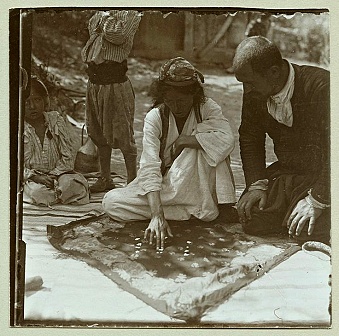Favomancy is a form of divination that involves throwing beans on the ground and interpreting the patterns in which the beans fall; it is therefore a type of cleromancy. Various forms of favomancy are present across the World cultures. The term favomancy comes from the Latin faba "bean" and formed by analogy with the names of similar divination methods such as alectromancy.
Favomancy used to be practised by seers in Russia, in particular, among the Ubykh. Russian methods of favomancy may still exist; however, since the departure of the Ubykhs from the Caucasus in 1864, details of exactly how Ubykh soothsayers interpreted the patterns formed by the beans are lost.[1] The Ubykh term for a favomancer simply means "bean-thrower", and later became a synonym for all soothsayers and seers in general.[2]
In Bosniak traditions of Bosnia and Herzegovina, favomancy is is called bacanje graha 'bean-throwing' or falanje (from Persian fal 'to bode'). The fortune-teller places 41 beads of white beans onto a flat surfaces, dividing them into smaller groups using a complex set of rules. The resulting numbers of beans in each group are then interpreted as favorable or unfavorable signs in different aspects of life.[3]
Both Russian and Bosnian methods are remarkably similar, and likely share a common origin. Since the method is not present in the West, it is possible that the origin might be in the middle East. In Iran, a similar method exists, involving fifty-three peas.
Favomancy used to be practised by seers in Russia, in particular, among the Ubykh. Russian methods of favomancy may still exist; however, since the departure of the Ubykhs from the Caucasus in 1864, details of exactly how Ubykh soothsayers interpreted the patterns formed by the beans are lost.[1] The Ubykh term for a favomancer simply means "bean-thrower", and later became a synonym for all soothsayers and seers in general.[2]
In Bosniak traditions of Bosnia and Herzegovina, favomancy is is called bacanje graha 'bean-throwing' or falanje (from Persian fal 'to bode'). The fortune-teller places 41 beads of white beans onto a flat surfaces, dividing them into smaller groups using a complex set of rules. The resulting numbers of beans in each group are then interpreted as favorable or unfavorable signs in different aspects of life.[3]
Both Russian and Bosnian methods are remarkably similar, and likely share a common origin. Since the method is not present in the West, it is possible that the origin might be in the middle East. In Iran, a similar method exists, involving fifty-three peas.
Admin: komentar modifikovan dana: Wed Jul 08, 2015 5:31 pm; prepravljeno ukupno 1 puta






» Arapska magija - DA POLUDI OD LJUBAVI
» ĆAROBNO JURJEVO (23.APRIL)
» DAN KADA JE IRAN UNIŠTIO SVE MITOVE I LAŽI JADNOG I MALOG IZRAELA
» Vještičje tajne uspjeha, sreće i zaštite od zla
» GENOCIDE IN GAZA - THE EVENT THAT TURNED THE JEWS FROM VICTIMS INTO WAR CRIMINALS
» What Is Genocide?
» GENOCID U GAZI – DOGAĐAJ KOJI JE JEVREJE OD ŽRTVE PRETVORIO U RATNE ZLOČINCE
» Pouzdan test za otkrivanje da li ste pod uticajem magije